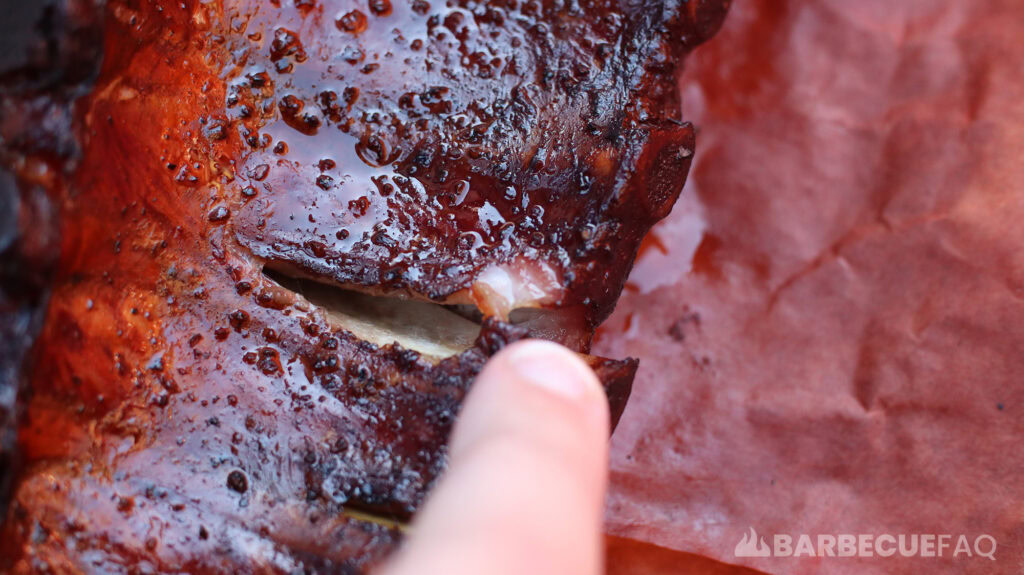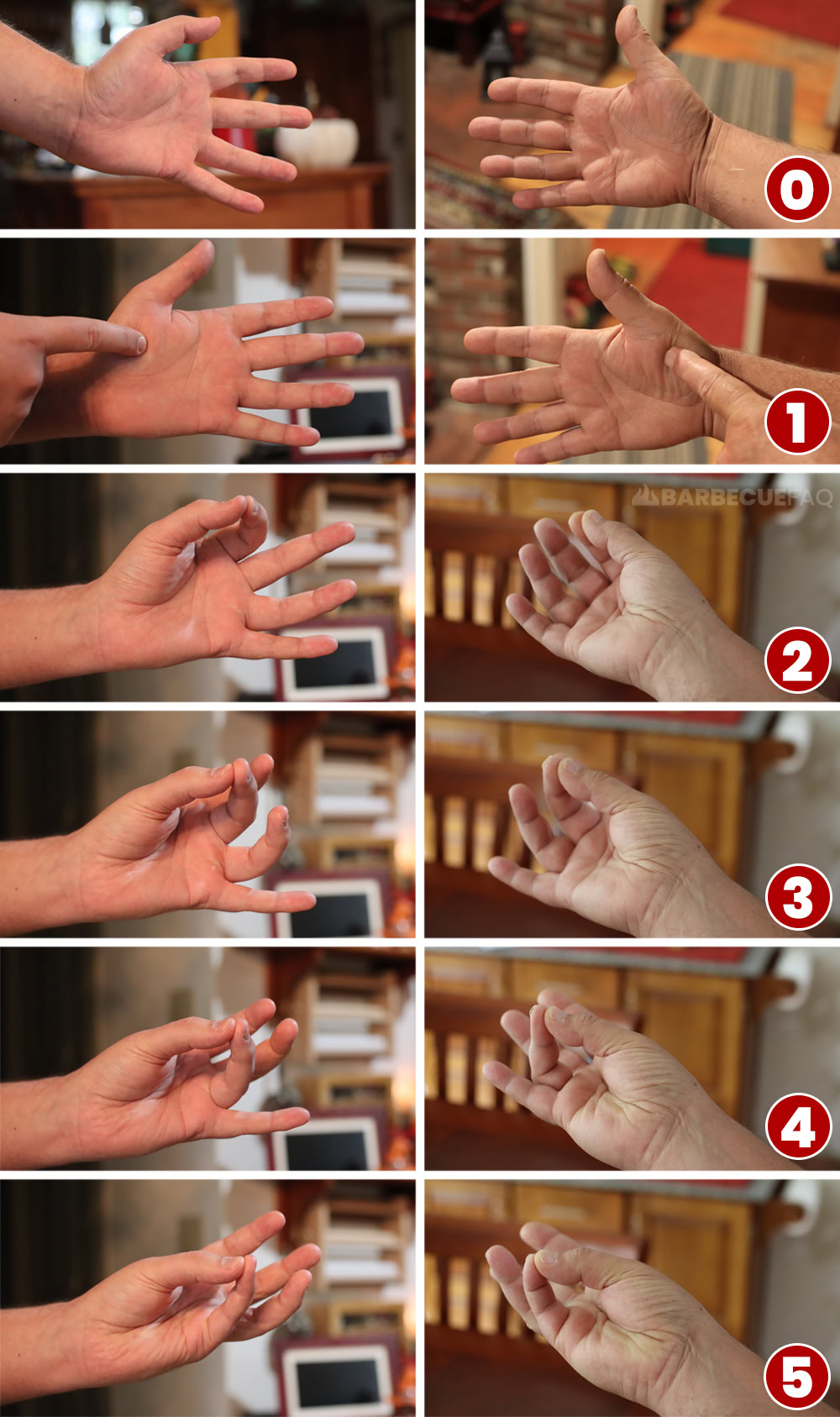By Dylan Clay
The best way to tell when a steak is “done” is to check for internal temperature with a meat thermometer; That’s it, full stop.
For some reason a number of resources will have you touching different parts of your hand or face in order to determine steak done-ness. The problem with these methods is that there are several uncontrollable variables, namely:
In order to help explain this, I’ll be comparing my hands to my father’s below.
In barbecue, you sort of develop a “feel” for when things are cooked properly – the same could be said for all repeated things in life.
For instance, ribs being “probe” tender is a good sign that they’re done – where-as temperature can be hit or miss; Pork and beef ribs typically finish at around 195 – 205F. However, if the meat isn’t “probe tender,” they’re not considered done.
The same could be said for using the twist, tear, and bend tests. These are sensory queues that you sort of learn after a while of working with different cuts of meat.

In a Kitchen, a Chef cooks the same cuts of steak to the same internal temperatures and has a good idea of how their stove and/or grill works.
Meaning, they know the time it takes to get to rare, medium-rare, medium-well, etc. However, once you introduce an unknown variable – like a new cut of steak or a higher grade (like Wagyu) – their consistent output goes away.
As someone who cooks on a grill, you will sort of develop the same set of skills over time.
You’ll use the same grill, the same level of heat, cooked on the same grates, for a set amount of time; You’ll likely even grill the same cuts of steak. However, once you introduce a new cut of meat you’ve never worked with, you’ll have no idea how to determine internal temperature.
The main issue with these methods lies in the fact that every person has different physiology. Meaning my hands are different from my Father’s hands, and his hands are different from my Mother’s hands and so on; The same could be said for his face, my face, her face, etc.
To illustrate, here’s a look at my Father’s hands and my hands at the various stages of steak “doneness.” My hands are pictured left, my Father’s hands are pictured right.
For reference: 0 is a baseline, 1 is rare, 2 is medium-rare, 3 is medium, 4 is medium-well, 5 is well done.

We can start to see the problem here. If I were to cook a Ribeye steak and wanted to finish at “Medium-rare,” I’d use my middle-finger touching my thumb.
However, my Father likes his steak rare. My hands are entirely different from his, so should I call him over and have him touch his pointer finger to his thumb and then allow me to feel his hand?
My mother prefers her steak medium, should I then call her over and have her touch her ring finger to her thumb and feel her hand?
Maybe there is a universal hand that I need to touch to act as my control variable to compare it to?
You get the point, I hope.
In order to know exactly when steak is cooked to a desired level of doneness, you should use a meat thermometer.

Certified Angus Beef gives us the following temperatures in terms of steak doneness.
| Doneness | Temperature |
|---|---|
| Rare | 125F (52C) |
| Medium-rare | 135F (57C) |
| Medium | 145F (63C) |
| Medium-well | 150F (66C) |
| Well Done | 160F (71C) |
A meat thermometer is a tool specifically designed to ascertain the internal temperature of meat.
Meaning, rather than touching my middle-finger to my thumb and comparing the sensations of touching my steak to my hand, I’d just take the steak off the grill at or around 130F; Due to carry-over cooking it will finish between 135-140F or Medium-rare when you slice it.
Over the years I’ve owned a number of different meat thermometers, however, I currently use the ThermoWorks Thermapen MK4 – You can read my review here.
“Steak” is an all encompassing term referring to dozens of different cuts of meat. This is sort of where another issue stems from and why the face and hand touch tests result in inconsistent results.
In an article I wrote about cutting meat against the grain, I brought up how the purpose of doing so is to shorten muscle fiber lengths. Typically, the closer the meat is to the hooves, the tougher the meat – these muscles are heavily worked and as a result, extensive muscle fibers form.
On a weak muscle like a loin or tenderloin, regardless of how you cut it, it will be soft and tender.
This is further illustrated by America’s Test Kitchen where-in they used a CT3 texture analyser in order to simulate the force required to cut 5 mm into the meat. For their example, they used Flank Steak and Strip loin.
| Flank Steak | Strip Loin | |
| with the grain | 1729g | 590g |
| against the grain | 383g | 329g |
As we can see, the Flank steak requires 4.5x the force when sliced with the the grain. Where-as the strip-loin requires 1.79x as much force. Flank steak is much closer to the hooves and strip-loin is considered a weak muscle.
This same concept (compress-ability) applies to these touch tests and why they’re flawed. This is even further complicated by the grading of the beef as intramuscular fat can also affect compress-ability.
Again, for these touch tests there is no universal steak that’s used – where-as something like temperature is constant.
It’s important to quickly note that there are times where ensuring meat is entirely cooked is necessary.
The following information is referenced from my article on Blue Steak and the safety of it’s consumption.
The United States Department of Agriculture (USDA) recommends an internal temperature of at least 145F for cuts of beef, with a 3 minute rest time, in order to prevent food-borne illness and 160F when ground (as the bacteria is distributed).
The Food and Drug Administration (FDA) recommends that individuals that are susceptible to developing food-borne illness entirely avoid raw or under-cooked beef due to risks associated with Toxoplasmosis and other food-borne diseases.
Meaning, using your fingers or face in order to essentially guess as to whether or not a cut of beef is entirely cooked could put a Pregnant Woman’s unborn fetus at risk. You should use a meat thermometer and confirm the internal temperature is at least 145F with a three minute rest time.
